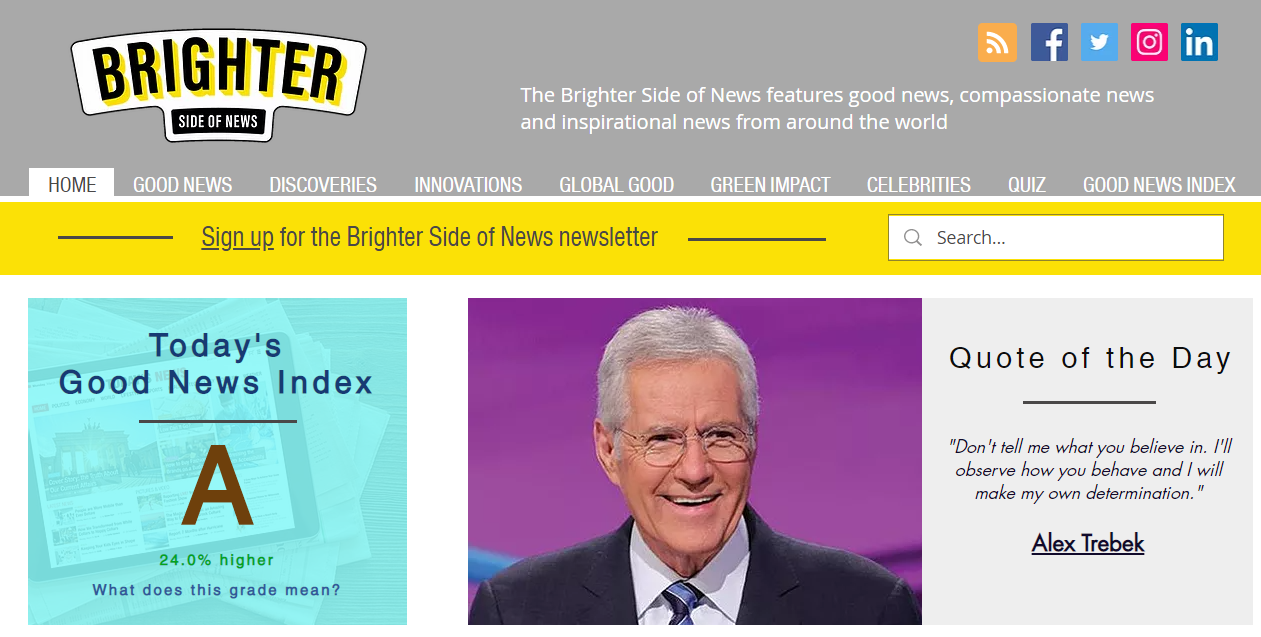The first “A” rated news day in Good News Index history
News, in whichever form it is delivered has a singular functional goal; elicit a response. Publishers monetize

[Nov. 9, 2020: The Brighter Side of News]
Ever wonder why you feel depressed scrolling through your morning news feed or favorite news website? Have you heard of "Doomscrolling" or "Doomsurfing"? Have you heard of the broadcast news adage "if it bleeds it leads"?
News reporting is designed to elicit a strong response irrespective of channel.
News, in whichever form it is delivered, has a singular functional goal: elicit a response. Publishers monetize their content almost exclusively via "eyeballs" which are driven by viral actions such as a click, a share, a like, a tweet, a retweet, etc. The more you talk about and consume a story, the more people read it and the more money they make as a result. In short, the more provocative the news item, the more it is consumed and the better the return on investment.
What is the Good News Index?
The Good News Index is a daily measure of how much positivity is being promoted by online media sources (websites, social media, news aggregators, etc.) in relation to negative news stories. It is proprietary to The Brighter Side of News and its goal is to provide insight into the emotional mood of the country based on news sentiment. The higher the score (then translated into a grade), the more positive a reader may feel after reading the news today.
You can learn more about how the Good News Index is calculated here.
What made Nov. 9, 2020 an "A" news day?
The first thought some might have is that the recent Presidential election results had an impact. Actually, they didn't have a direct effect at all in the calculation. Political stories generally regarded as "negative" or "neutral" in our algorithm. The only times political stories count as "Good News" are when there is a deeper value to the story. For example, the story "Madison Cawthorn of North Carolina will be youngest member of Congress in modern history" was categorized as Good News (a few days ago) because Mr. Cawthorn made history as the youngest member of Congress irrespective of his political affiliation. He broke a barrier.
Lots of good news stories, placed higher up in the list of stories results in a more even tone and a higher score. Today's score was predominantly driven by "Good News" stories like these below.
and several others...
Note that the media outlets scored within the GNI analysis write their own versions of stories, so the above links were simply the versions of the stories chosen by The Brighter Side of News editors for inclusion within our daily directory.
Like these kind of stories? Get The Brighter Side of News' newsletter.
What can publishers do to increase their GNI scores?
The keys to a higher GNI score and grade are balance, tone and sentiment.
Balance: Help avert Doomscrolling by balancing out negative sentiment stories with positive stories. Don't hide the positive stories or force readers to scroll through 30 negative stories to start seeing them.
Tone: How a story is positioned to readers is important. A news story's title has a large impact on how readers feel about the story and its content. For example, here are three titles from three different websites for essentially the same story. Which title (as a reader) would you feel least good about reading?
Kamala Harris Makes History as First Woman and Woman of Color as Vice President
Harris bursts through another barrier, becoming the first female, first Black and first South Asian vice president-elect
Why Kamala Harris could become an unapologetically Black vice president
Content Sentiment: The words used in the story matter. Through sentiment analysis we score each version of a story from multiple publishers to determine the version which has the highest positive sentiment. For example, in the list of Tone examples above, the word phrasing of "unapologetically Black vice president" scores lower in sentiment analysis than the words "busts through another barrier".
What scores will tomorrow bring?
The GNI score changes every day. Hopefully over time we'll see a trend upwards and a consistency where we'll see more A and B days. We think that this is something we can all agree on!
Tags: #GoodNews, #Good_News_Index, #Los_Angeles, #California, #The_Brighter_Side_of_News



